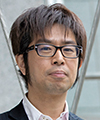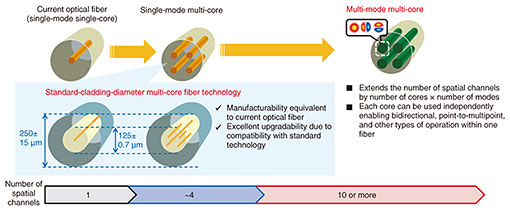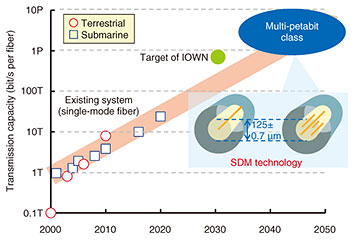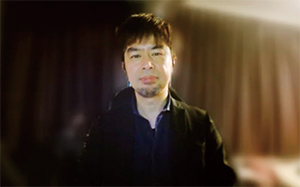 |
|
|
|
|
|
Rising Researchers Vol. 21, No. 9, pp. 11–15, Sept. 2023. https://doi.org/10.53829/ntr202309ri1  Transmission Technology for Space-division Multiplexing Supporting Next-generation High-speed, Large-capacity Communications beyond Existing LimitsAbstractRecent years have seen remarkable developments in information and communications technology and a dramatic increase in communications traffic. The capacity limit in existing optical fiber supporting such communications is about 100 Tbit/s per optical fiber, and it is predicted that transmission systems using this optical fiber will reach this limit in due time. In this interview, we talked with NTT Distinguished Researcher Takashi Matsui about his research on solving this transmission capacity problem by greatly expanding optical transmission capacity using “optical fiber transmission line technology for space-division multiplexing.” Keywords: optical fiber, space-division multiplexing, multi-petabit class Optical fiber transmission line technology for space-division multiplexing for achieving a multi-petabit-class transmission infrastructure—Dr. Matsui, what exactly is “optical fiber transmission line technology for space-division multiplexing” for solving the transmission capacity problem? Optical fiber transmission line technology for space-division multiplexing (SDM) prepares multiple light paths within optical fiber to perform communications and achieves far more transmission capacity than existing technologies. In recent years, the usage scenarios of information and communications technology (ICT) have become quite diverse producing a sharp rise in the demand for transmission capacity. For example, the core network that bundles and transmits communications signals over long distances between prefectures in Japan currently implements an optical transmission system having a transmission capacity of 16 Tbit/s per optical fiber, which represents an increase of about 1000 times over the last 20 years. The capacity limit of optical fiber now in common use is predicted to be about 100 Tbit/s per optical fiber, so we can expect the current optical transmission system to reach its limit around 2030 due to the rapidly rising demand for communications. The solution to this problem in next-generation transmission capacity is SDM optical fiber transmission line technology. The mainstream form of optical fiber used in today’s optical transmission system is single-mode fiber that transmits signals through only one path per optical fiber. In contrast, SDM optical fiber transmission line technology transmits signals through multiple, independent paths per optical fiber. Since increasing the number of paths by n times increases transmission capacity by approximately n times, it becomes possible to dramatically expand transmission capacity beyond comparison with existing technology. To increase the number of optical paths in a single optical fiber, we research SDM optical fiber transmission line technology mainly from two perspectives: the part of the fiber that passes light called a “core” and the way in which light propagates through a core called a “mode.” There are three specific approaches here: multi-core fiber that incorporates multiple cores, multi-mode fiber that sets multiple modes in a single core, and multi-mode multi-core fiber that combines the above two technologies. In the case of multi-core fiber that is as thin as current optical fiber, the maximum number of single-mode cores is four. On the other hand, multi-mode multi-core fiber enables light to propagate in multiple spatial modes per core, which makes for excellent extendibility. As an example, establishing three modes within each of four cores means that light can propagate through 3 × 4 = 12 paths (spatial channels), which opens up the possibility of expanding transmission capacity by a significant amount. In addition, combining this feature with technology for expanding wavelength bands in optical fiber is expected to greatly expand transmission capacity beyond what ever could be achieved by conventional technologies (Fig. 1).
—What are some of the difficulties that have to be overcome in SDM optical fiber transmission line technology? In multi-core fiber having multiple cores in a single optical fiber, a phenomenon called “crosstalk” arises in which light leaking into a neighboring core creates interference. This crosstalk can significantly reduce transmission capacity to an extent that prevents transmission capacity to be increased by n times by increasing the number of paths by n times. At NTT, we are working to solve this problem by attempting to fit as many cores as possible into a single optical fiber while making the inter-core distance large enough to prevent the generation of crosstalk. Of course, making the diameter of the optical fiber larger would enable the number of cores to be increased. However, thicker optical fiber creates problems in relation to physical properties such as making it hard to bend the fiber when laying and making it difficult to handle the fiber cable overall. On top of this, making the diameter of optical fiber larger means increasing the amount of glass material used, which can greatly degrade the manufacturability of optical fiber. When setting out to deploy optical fiber in actual facilities, these problems in physical properties and ease-of-handling and in manufacturing cost take on great importance. So researching without taking these problems into consideration can lead to a result in which no one would be able to use the optical fiber. It is for this reason that searching for an optimal number of cores while maintaining the conventional diameter of optical fiber has become a key research issue. In parallel with this research, we are also researching the expansion of wavelength bands in optical fiber. At present, systems are configured with optical fiber in which signals are packed into a region limited to a bandwidth of about 35 nm called the C-band in the 1.5-μm range. If this wavelength band can be expanded so that a wide range of wavelengths can be used, a quantum leap in transmission capacity should become possible. We are therefore conducting research with the aim of expanding the wavelength band to the 1.6-μm band, for example, to support the need for greater transmission capacity with NTT’s vision of the Innovative Optical and Wireless Network (IOWN) in mind. In the design of optical fiber, the task is to find a wavelength band in which sufficient transmission quality can be obtained by controlling changes in the refractive index and optical characteristics of optical fiber. However, two key technical problems in SDM optical fiber are “crosstalk increases when expanding the upper wavelength limit (to longer wavelengths)” and “light can easily leak when expanding the lower wavelength limit (to shorter wavelengths).” In optical-fiber structures up to now, shortening the lower wavelength limit and lengthening the upper wavelength limit have had tradeoffs, so we are exploring new optical-fiber structures and manufacturing methods that can significantly increase transmission capacity while searching out wavelength bands that can be used. —What have been some of the achievements of SDM optical fiber transmission line technology to date? As one achievement of SDM optical fiber transmission line technology, our research group successfully performed a relay transmission experiment exceeding a transmission capacity of 100 Tbit/s per optical fiber in cooperation with industry, academia, and government in 2017. We did this by using a transmission line that interconnected 4-core multi-core fibers fabricated by multiple vendors. We have also been researching the number of cores and modes that can fit within a certain fiber thickness for which the optical fiber breakage rate can be sufficiently tolerated. In 2018, we demonstrated a 10-mode, 12-core multi-mode multi-core fiber thereby achieving the world’s highest number of spatial channels at 120. In research reports on SDM optical fiber up to now, extremely diversified structures have been proposed in terms of the number of cores, thickness of the optical fiber, and other parameters. However, when actually making optical fiber into a product and using it in communications facilities, connectivity between optical fibers and compatibility with other devices and facilities must be ensured. For this reason, NTT took the worldwide lead in proposing that the thickness of optical fiber be maintained at 0.125 mm as used by existing single/multi-mode fiber and that four cores are optimal in transmission by multi-core fiber. These research efforts have progressed through collaboration with many experts and individuals from the NTT Group. When arriving at the stage of installing optical fiber, a variety of technologies that are needed to configure a total optical communications system must be studied in addition to connectivity, such as input/output methods, transmission-equipment and system configuration, and operation methods. Our research has been making good progress by receiving feedback from many people. In view of a 125-fold increase in transmission capacity as a target of the All-Photonics Network in NTT’s IOWN vision, we are aiming for a transmission capacity potential of more than 10 times in an optical fiber transmission line as our research target going forward. To achieve this target, the first step in our research plan for SDM optical fiber transmission line technology is to focus our attention on establishing technology for 4-core multi-core fiber having high affinity with existing optical technology. Additionally, while using this 4-core multi-core fiber technology as a basis to work from, we will explore methods of establishing technology that can extend the number of spatial channels in one direction to 10 or more and thereby achieve a transmission capacity potential of more than 10 times in an optical fiber transmission line. Moreover, taking into account present capacity demands, it is predicted that the demand for transmission capacity will increase to the multi-petabit class from 2040 on. We therefore want to work on establishing technology that can also support the future beyond IOWN. Furthermore, in addition to high-density SDM optical fiber starting with multi-mode multi-core fiber, we will also work on technology for controlling wavelength characteristics. Our aim here is to establish new optical fiber transmission technology that can achieve transmission capacity 50 times that of current levels and support transmission capacity of the multi-petabit class (Fig. 2).
Placing importance on the user’s point of view—flexible thinking builds a new future—What way of thinking should be valued in research? In my many years of research, I have often witnessed the appearance of optical fiber and devices based on totally new concepts different from those of the past. At the research stage, this can be quite exciting, but a pitfall here is that a new fiber or device may turn out to be useless when it comes time for actual implementation. Of course, when you are pursuing only the research immediately in front of you, no value is being created. To some extent, I think it’s very important to strike a balance between an awareness of how research is to be used in the future and taking up the challenge of new, cutting-edge research, and then set and prioritize themes. No matter how interesting a certain research theme may be, I believe it is meaningless if it comes to be used nowhere in the end. I myself have experienced such a failure any number of times, and to avoid making the same mistake again, I conduct my research while listening to diverse viewpoints and exchanging opinions with experts in other organizations and fields and manufacturers too. In this way, I can expand my field of vision. In fact, NTT Access Network Service Systems Laboratories that I belong to is in charge of all sorts of technologies that are needed in the network to connect customers with central offices. It deals with a very broad range of technical fields from civil-engineering facilities, optical facilities, and wireless facilities to operations and services. Because it has facilities throughout Japan, it has high technical competence and a great ability to make judgments on the specifications, construction, and operation of those facilities all the way from research and development to implementation and operation. I believe that this is a major strength of NTT Access Network Service Systems Laboratories. In addition, I feel that the ability to develop and implement technologies while fortifying our ties with NTT Group companies and discussing their needs is very reassuring for researchers. The achievements that have come about through the efforts of senior researchers are also encouraging. Moreover, I have many opportunities to hear what people in standardization organizations and academic societies outside of NTT have to say, and I can conduct my research while exchanging opinions with a wide range of people. Interacting with people in a variety of situations is truly a blessing. I believe that this sort of environment is very important for achieving success in research.
—Dr. Matsui, could you leave us with a message for researchers, students, and business partners? Today, technology is progressing, and we are entering an era in which many people, myself included, can feel its benefits. Technology will continue to evolve: communications in our daily lives will become even more convenient through wireless technologies, and cutting-edge services and social innovations will be driven by virtual reality, artificial intelligence, and other types of advanced software. From here on, however, optical transmission facilities will become indispensable to support such high-speed communications and new social developments. Yet, in recent years, it has become difficult to focus on technologies related to the communications infrastructure as they tend to be hidden by software-based technical fields in the digital space. So the communications infrastructure is perhaps a low-profile field, but if new technologies in this field can be released to the world, I think they would have great potential in driving dramatic changes in existing industries and today’s society. Going forward, I myself would like to promote top-level research results throughout the world and contribute to the development of new optical communications facilities including the standardization of these results in a form that can provide for practical deployment. In this endeavor, I look forward to everyone’s support. Additionally, while I hope that this will be the desire of people involved in the research of optical communications from here on, there is still much room left for discussion in how this field should continue to develop and in what way new technologies should be pursued. If a flexible way of thinking can be adopted as in the merging of our technologies with technologies in other fields, I believe that the entire optical communications field can be energized and that the future of the communications infrastructure can be made bright indeed. To those who can sow the seeds of such flexible thinking and to readers who find this article interesting, I would say, “Let’s work together to build a new future for optical communications.” ■Interviewee profileTakashi Matsui received his M.E. in electronic engineering from Hokkaido University in 2003 and entered NTT in the same year. He received his Ph.D. in electronic engineering from Hokkaido University in 2008. He has been an NTT distinguished researcher since 2022. He is engaged in the research of optical fiber transmission line technology for space-division multiplexing toward a dramatic expansion of space and wavelength resources. He is a recipient of the Japanese Ministry of Economy, Trade and Industry (METI) International Standardization Contributor Award in 2021, SPIE Photonics West 2021 Best Technical Paper Award, and OECC/PS 2019 Best Paper Award among other awards. He has been a visiting professor at the College of Engineering, Ibaraki University since 2022. |



